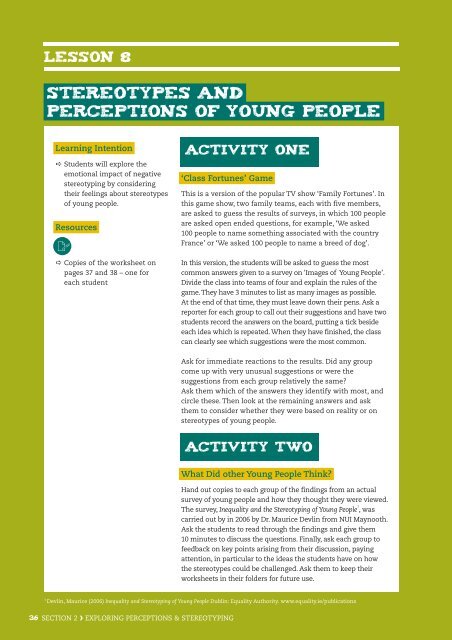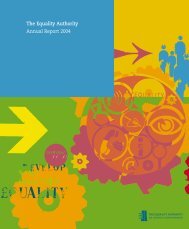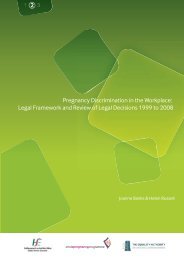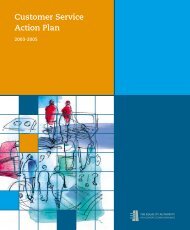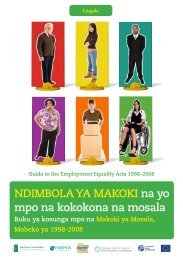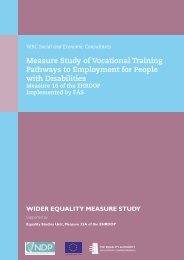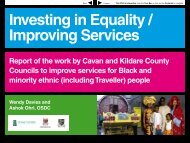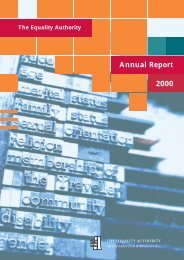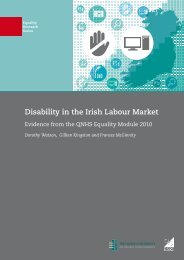Equality and Diversity - Building a Culture of ... - Equality Authority
Equality and Diversity - Building a Culture of ... - Equality Authority
Equality and Diversity - Building a Culture of ... - Equality Authority
You also want an ePaper? Increase the reach of your titles
YUMPU automatically turns print PDFs into web optimized ePapers that Google loves.
Lesson 8<br />
Stereotypes <strong>and</strong><br />
Perceptions <strong>of</strong> Young People<br />
Learning Intention<br />
Students will explore the<br />
emotional impact <strong>of</strong> negative<br />
stereotyping by considering<br />
their feelings about stereotypes<br />
<strong>of</strong> young people.<br />
Resources<br />
<br />
Copies <strong>of</strong> the worksheet on<br />
pages 37 <strong>and</strong> 38 – one for<br />
each student<br />
Activity one<br />
‘Class Fortunes’ Game<br />
This is a version <strong>of</strong> the popular TV show ‘Family Fortunes’. In<br />
this game show, two family teams, each with five members,<br />
are asked to guess the results <strong>of</strong> surveys, in which 100 people<br />
are asked open ended questions, for example, ‘We asked<br />
100 people to name something associated with the country<br />
France’ or ‘We asked 100 people to name a breed <strong>of</strong> dog’.<br />
In this version, the students will be asked to guess the most<br />
common answers given to a survey on 'Images <strong>of</strong> Young People’.<br />
Divide the class into teams <strong>of</strong> four <strong>and</strong> explain the rules <strong>of</strong> the<br />
game. They have 3 minutes to list as many images as possible.<br />
At the end <strong>of</strong> that time, they must leave down their pens. Ask a<br />
reporter for each group to call out their suggestions <strong>and</strong> have two<br />
students record the answers on the board, putting a tick beside<br />
each idea which is repeated. When they have finished, the class<br />
can clearly see which suggestions were the most common.<br />
Ask for immediate reactions to the results. Did any group<br />
come up with very unusual suggestions or were the<br />
suggestions from each group relatively the same?<br />
Ask them which <strong>of</strong> the answers they identify with most, <strong>and</strong><br />
circle these. Then look at the remaining answers <strong>and</strong> ask<br />
them to consider whether they were based on reality or on<br />
stereotypes <strong>of</strong> young people.<br />
Activity two<br />
What Did other Young People Think?<br />
H<strong>and</strong> out copies to each group <strong>of</strong> the findings from an actual<br />
survey <strong>of</strong> young people <strong>and</strong> how they thought they were viewed.<br />
The survey, Inequality <strong>and</strong> the Stereotyping <strong>of</strong> Young People 1 , was<br />
carried out by in 2006 by Dr. Maurice Devlin from NUI Maynooth.<br />
Ask the students to read through the findings <strong>and</strong> give them<br />
10 minutes to discuss the questions. Finally, ask each group to<br />
feedback on key points arising from their discussion, paying<br />
attention, in particular to the ideas the students have on how<br />
the stereotypes could be challenged. Ask them to keep their<br />
worksheets in their folders for future use.<br />
1<br />
Devlin, Maurice (2006) Inequality <strong>and</strong> Stereotyping <strong>of</strong> Young People Dublin: <strong>Equality</strong> <strong>Authority</strong>. www.equality.ie/publications<br />
36 sECTION 12 EXPLORING Exploring DIVERSITY<br />
Perceptions & Stereotyping


